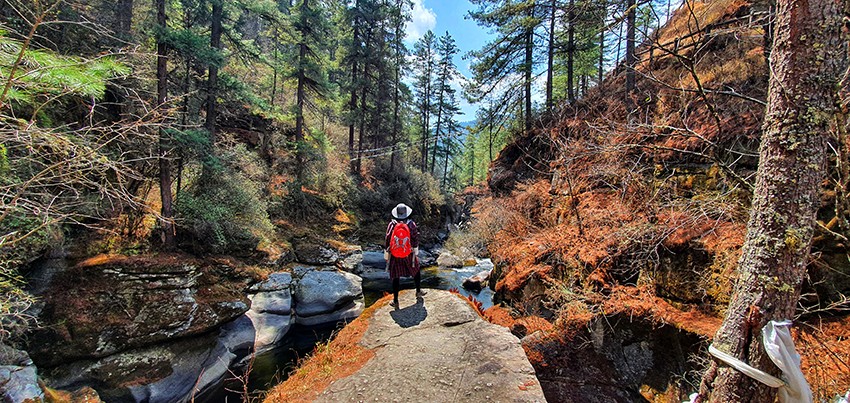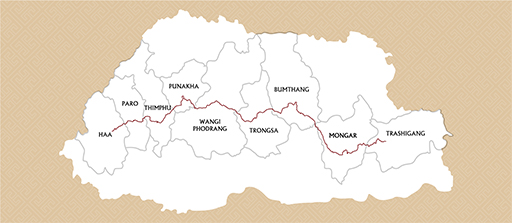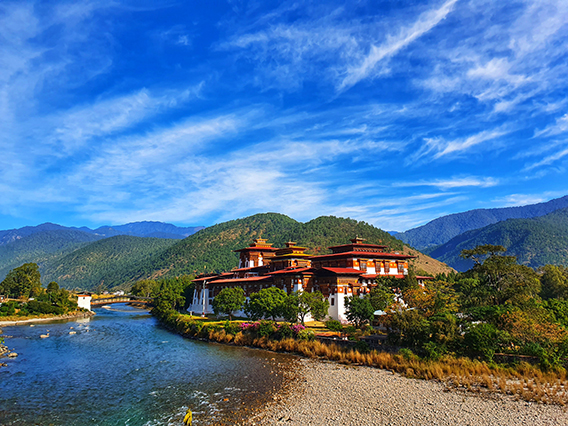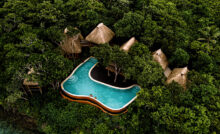The Trans Bhutan Trail Has Been Restored!


For hundreds of years, the Trans Bhutan Trail was used by pilgrims, messengers, armies and traders. Until the 1960s, it was the only way to travel and communicate with others across the country. Now, it has found a new life for an age of adventure and connection.
The Trans Bhutan Trail is a 403km route, spanning from Haa in the West of Bhutan to Trashigang in the East. It is considered one of the world’s greatest walks and one of the best hiking routes in Asia. The Trail will now open to visitors from all over the world on September 28, 2022, allowing travelers to explore the mystique of this land.


The path that was once used by monks, messengers, traders, and pilgrims fell into disrepair as the national highway was constructed in the 1960s. With the foresight of His Majesty The King of Bhutan and the support of the Tourism Council of Bhutan, the Bhutan Canada Foundation led the revival of the ancient Trail, making it accessible once again to locals and visitors alike. The Trail connects the town of Haa, in the western extremes of Bhutan and near the border with Tibet, with Trashigang in the East, bordering Arunachal Pradesh. The restoration of the Trail is intended both as a homage to Bhutan’s ancestors, and as a gift to its present and future generations.




The full Trans Bhutan Trail experience, 36 day End-to-End itinerary, can also be broken down into smaller, accessible routes. The Trail contributes significantly to sustainable development, setting global standards for environmental preservation. The Trail visits 27 Gewogs, 4 Dzongs, 21 temples, 12 mountain passes, 5 suspension bridges, 10 cantilever bridges, 77 chortens and 30 stupas. It crosses a variety of terrain, from lush rice paddies, rhododendron forests, thick wilderness, to remote villages, and bustling towns. It also goes through some of Bhutan’s most major cities including Thimphu the capital and the royal city of Bumthang. It is hoped that the Trans Bhutan Trail will benefit the communities along the route by providing new opportunities for economic growth.
Sam Blyth, Chair of the Bhutan Canada Foundation, the not-for-profit organization behind the restoration of the Trail conveys, “The Trans Bhutan Trail will significantly contribute to the expansion of sustainable and ecotourism by encouraging intrepid visitors and explorers from India to participate in community-based experiences. Our aim is to help local communities to enhance tourism amenities and provide visitors with the experience of a lifetime.”
True adventurers can complete the trail in just over a month. Half-day and full-day treks are also available, with three, four, or seven-day section hikes expected to be popular among most visitors. The Trail offers a diverse experience for birdwatchers and botanists, photographers, rafters and runners, and those seeking spiritual, wellness, or religious fulfillment. Signature campsites, homestays, and hotels will be available along the way. Curated options for shorter-duration tours are also available.
More from our site
Recent Posts
The New Defender OCTA: Epitome of Power, Luxury and Performance
New Defender OCTA is the most dynamically accomplished Defender ever created, with unmatched breadth of capability and performance both on- and off-road
New Defender OCTA is the most dynamically accomplished Defender ever created, with unmatched breadth of…
Shaping Tomorrow’s Golf Champions With Leela Palace Bengaluru
The 3rd edition of The Leela Golf Tournament celebrated young talent and brought together skill, precision and camaraderie!
The 3rd edition of The Leela Golf Tournament celebrated young talent and brought together skill,…
The Duo Behind Late Checkout, Redefines Hospitality
In conversation with the founders of Pawan Shahri and Nikita Harisinghani, the duo behind Chrome Hospitality Asia
In conversation with the founders of Pawan Shahri and Nikita Harisinghani, the duo behind Chrome…
Precision, Durability, and Swiss Legacy
Victorinox launches the Swiss Army collection, featuring three distinct models that emphasise exceptional quality, resistance and versatility
Victorinox launches the Swiss Army collection, featuring three distinct models that emphasise exceptional quality, resistance…
A New Era of Luxury Interiors With Sussanne & Gauri Khan
Sussanne Khan & Gauri Khan unite to bring an awe-inspiring, six-storey sanctuary of luxury, art, and design in Hyderabad
Sussanne Khan & Gauri Khan unite to bring an awe-inspiring, six-storey sanctuary of luxury, art,…
Air India x Lufthansa: Fly To These International Destinations Now
Expanding their codeshare partnership, Air India and Lufthansa Group have added 100 new routes to their combined network
Expanding their codeshare partnership, Air India and Lufthansa Group have added 100 new routes to…


